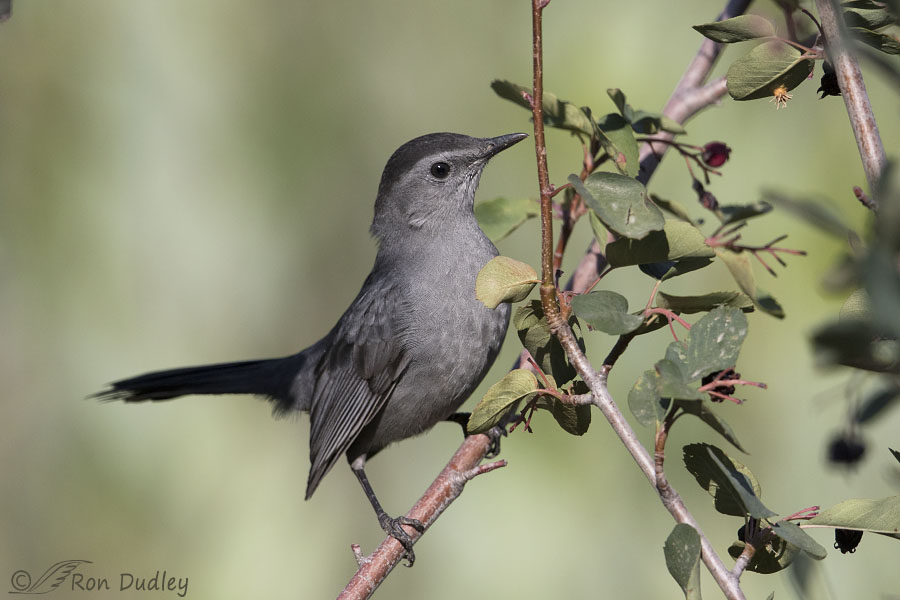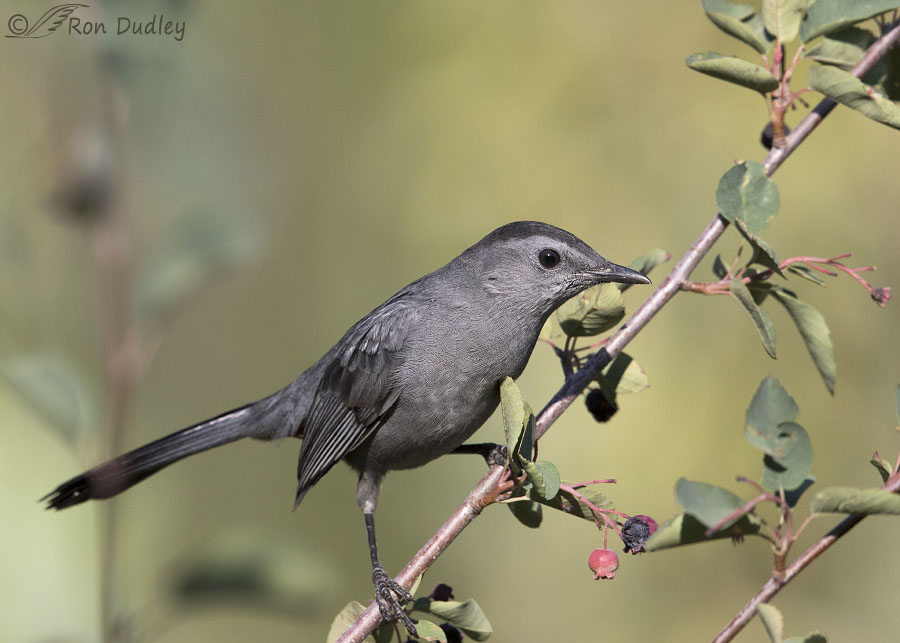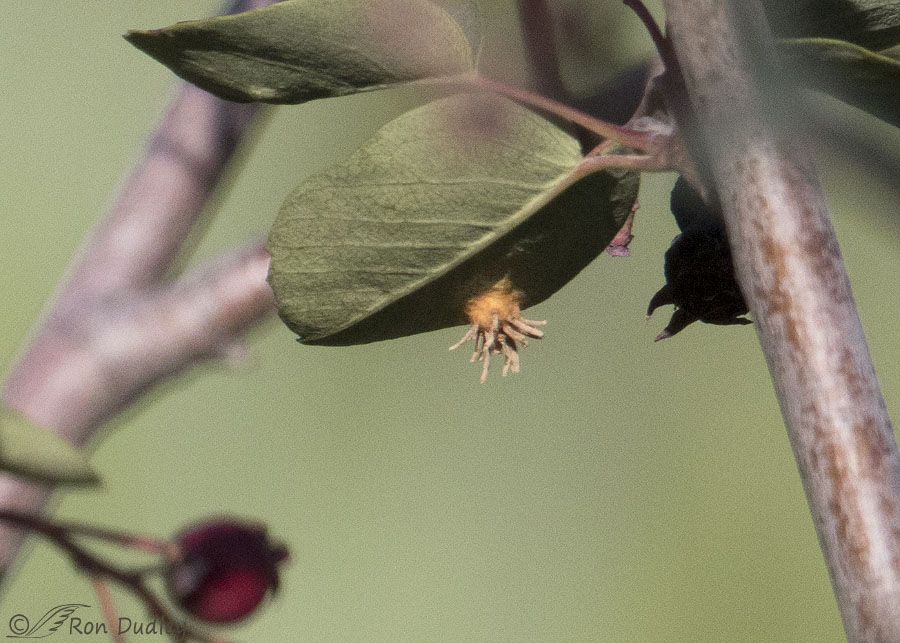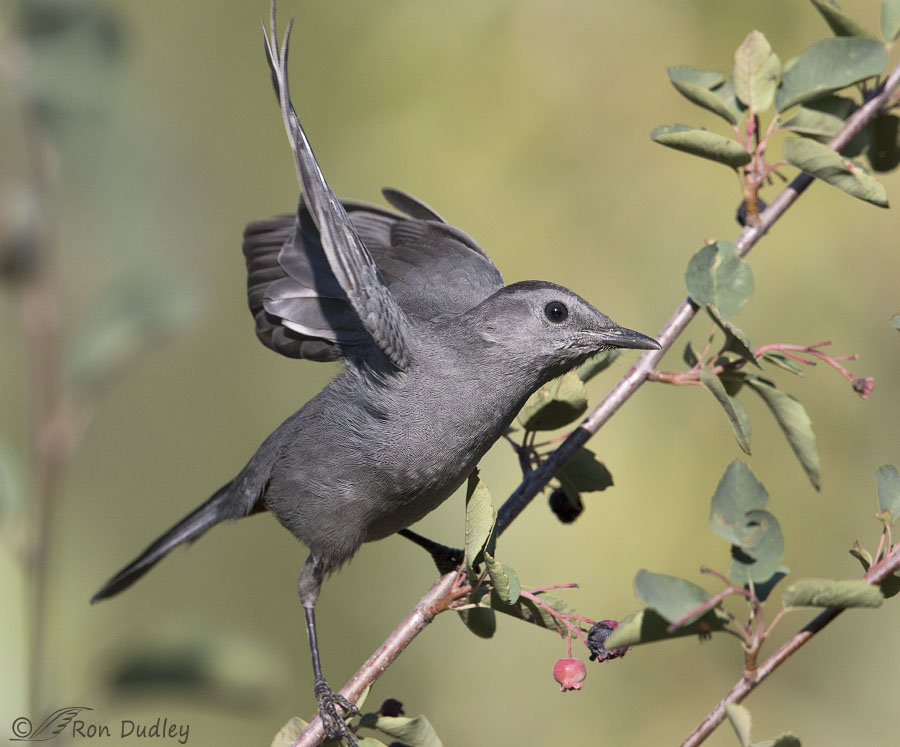Too close, actually. And that’s unusual for the very shy catbird.

1/5000, f/6.3, ISO 640, Canon EF 500mm f/4L IS II USM + EF 1.4 III Extender, not baited, set up or called in
I usually have a very difficult time getting close to catbirds but five days ago in the Wasatch Mountains this one.approached me rather than the other way around. I’m sure the draw was the few berries left on a scraggly serviceberry bush that was very close to me. All three of these images have at least one nit that needs picking but I’ll let them slide and just enjoy seeing the nice closeup detail on such a bashful bird.
Normally I’d crop a narrow slice off of the left side of the frame for slightly better composition but this photo as presented is full frame (uncropped) and I wanted to leave it that way to demonstrate how close the bird came in to me.

1/4000, f/6.3, ISO 640, Canon EF 500mm f/4L IS II USM + EF 1.4 III Extender, not baited, set up or called in
This photo of the same bird is nearly full frame but I did crop a little off of the left. I sure came close to clipping one of those toes.
1/4000, f/6.3, ISO 640, Canon EF 500mm f/4L IS II USM + EF 1.4 III Extender, not baited, set up or called in
But then I did clip both that toe and a wing primary when it began to take off. However, I’d say I was lucky to get as much of the bird in frame as I did.
Ok, now to that little mystery.

1/5000, f/6.3, ISO 640, Canon EF 500mm f/4L IS II USM + EF 1.4 III Extender, not baited, set up or called in
This is the exact same image as the first one above. Had you noticed that weird little orange structure hanging down from the underside of the leaf at upper right? I’m trying to figure out what it might be.

The only possibility I can think of is that it’s a leaf gall but it doesn’t resemble any galls I’ve seen before, especially because of those spikey projections hanging down that almost resemble the spines of some sea urchins and because of the fuzziness surrounding its round orange body – that fuzziness looks like a fungal characteristic.
I’m stumped. Any thoughts?
Ron
PS – I had to laugh at that berry in deep shadow on the right with a couple of sepals arranged in such a way to give it the appearance of a tiny ravenous bird with its hooked beak open flying in to attack the berry at lower left. Maybe it’s just me…
Addendum: Facebook follower Tana Peery Hunter thinks the orange mystery object resembles Sputnik. I wish I’d thought of that!



I’m not a mycologist (nor do I play one on TV), but I’ll pull my lever for the caterpillar fungus. Other than this mystery, you certainly are in the catbird’s seat! 😉
I hope to send that image to a knowledgeable source to ID it positively, Marty. If I get a positive ID I’ll report back.
Late to the party today and nothing to add about that strange “thingie” — but I will say I’ve never seen a catbird before and think this little guy is quite handsome! Now I have to consult my iBird app to see if there are other catbirds, as there are Gray Jay & Blue Jays (both of which I have seen). Beautiful bird photos, Ron, even with clipped wing & toe at take-off, such a great action shot!
If there are other species of catbird I’m unaware of them, Chris.
They’re so shy it took me years to get any decent shots of them. I think the key is just finding an area where they like to hang out, sit there as unobtrusively as possible (usually for a very long time) and then suddenly one just might pop into view for a few seconds – seemingly from out of nowhere.
Catbirds are lovely little folks and I love the feather detail in these shots, along with the background.
As for the sputnik thingie, I hope you can find out what it is. PLEASE let us know when you find out. That thing is just plain WEIRD!
“That thing is just plain WEIRD!
Agreed, Laura. That’s what caught my attention.
The catbird is a charmer. Loved the ravenous bird silhouette, and am intrigued at the mystery object. Impressed (as always) at your knowledgeable commentators too.
I’m very often impressed by them, EC. They’re good folks, too.
I went out and looked at my serviceberries and consulted my field guide to plant galls. Nothing. I’ll bet the Catbird knows. Nice photo and discussion.
Thanks for going to the trouble to look, Lyle. I’ll have to ask him/her next time we cross paths!
I miss catbirds.
I am a University of California certified master gardener, so let me recommend that you send the very interesting image of the unknown rust/fungus/gall to the Utah master gardener program https://extension.usu.edu/mastergardener/ and ask for an ID. Let us know what they say, please.
That sounds like a good idea, Martha. I have a lot on my plate for the next few days but hopefully I’ll get around to it.
I’ve never heard of this pretty bird❗️ Again this is why I love your blog always seeing something new.
Have a great day
Good to know, Diana. Thank you.
Nope…didn’t notice the orange sputnik or ravenous bird silouette,…too pleased with the rest of the photo of one of my favorite birds…ones that sing so beautifully and are so curious…(almost as curious as chickadees…another favorite). Love the composition(2/3 of the total mass is to the right..glad you didn’t crop left)–and the subject…especially their soft, blue-gray color and black accents. We have one here that sings as beautifully a varied song as any mockingbird…which we did have –used to sing at night under the street light, but which we haven’t had for a couple of years. I’ve missed it. Mockingbirds like rose hips…they came north when WII returning vets married, bought homes, and planted wild “living fences” rose bushes…our roses have died off and mockingbirds, disappeared when the roses did.
Patty, I was listening to faraway calling catbirds again this morning. So often they sound like some other bird or even critter.
I agree that the little orange thing is weird, but my first thought was an insect gall. I see a lot of those, and something I thought was insect eggs on the leaf of a scrub oak turned out to be an insect gall. If you can get it a bit more enlarged I would suggest submitting it to bugguide.net. They are absolutely amazing in what they know and how quickly they often come up with answers. You do have to sign up to be a member of the site to submit anything, but it’s free and you never hear from them unless you want to know about things you’ve submitted. I see lots of different insects and submit ID request to them all the time – couldn’t live without them.
I love that you were able to get so close to the Catbird. Its personality shows through in these shots. It looks to me like it might be eyeing that orange thing… And I also see the ravenous bird. It’s not just you.
Susan, I’ve probably already enlarged it more than I should have for best detail.
That “shadow bird” popped right out at me from the beginning.
It reminds me of aphid lions, the larvae of lacewings. It’s probably not that, but just an idea.
I’ll take any ideas folks might have, Mary.
Great series Ron!
Charlotte
Thanks, Charlotte.
Beautiful photo’s of the illusive gray catbird! 🙂 Heard more than seen for sure. No idea on what’s on the leaf. A quick glance would tell me it was the blossom end of a berry in the wrong place! – how observant I am/would be at times……;)
“Heard more than seen”
Boy, isn’t that the truth! Thanks, Judy.
Great catbird! Usually the ‘mews’ draw you in but you only catch a glimpse of the bird. Looks like the fungal disease ‘Cedar-Hawthorn Rust’ which can affect serviceberries I believe because of the botanical family relationships. It is one of those diseases that cross over two families of plants. I could be way off here but it is something to check. It just looks like the galls I’ve seen on Hawthornes, cedar. I’m heading north early today so when I return if you haven’t figured it out…
“Usually the ‘mews’ draw you in but you only catch a glimpse of the bird”
That’s exactly right, Kathy. A “glimpse” of the bird, if you’re lucky!
I did a quick google image search for Cedar-Hawthorn Rust and many of them look fairly similar to this. Now I’m really confused – so many possibilities out there!
I did a quick check…The “Missiuri Botanical Garden’ has a gardening fact sheet on Cedar-Hawthorn Rust with pictures of it on serviceberries. Looks like it but you saw it so you can compare it better.
I found the link.
http://www.missouribotanicalgarden.org/gardens-gardening/your-garden/help-for-the-home-gardener/advice-tips-resources/pests-and-problems/diseases/rusts/cedar-hawthorn-rust.aspx
They include two photos of Cedar-Hawthorn Rust on serviceberry but I’m not sure the resemblance to my example is very strong. Plus, that rust appears to grow mostly on the berries instead of the leaves.
Hmmm…. Veddy interesting! I have no idea what it is but I’ll love reading the responses to your post throughout the day in between work. Excellent photos once again.
Thanks, Joanne. I have many knowledgeable readers so it might be interesting…
Hi Ron,
I suggest the unusual object hanging under the leaf is a Cordyceps fungi that has parasitised an insect of some sort. Cordyceps are common place down here in Australia, and the basis of a large industry in Tibet where they are harvested for use in Chinese Traditional Medicine. They are currently the subject of considerable research attention. I don’t know enough of North American insect or fungal biology to make any further comment. Keep up the outstanding posts.
Gary, I did a little quick research and it does look like Cordyceps fungi is a strong possibility (even though they apparently are mostly found in humid environments and this environment is quite dry). Thanks very much for suggesting that possibility. I’ll do some further research.